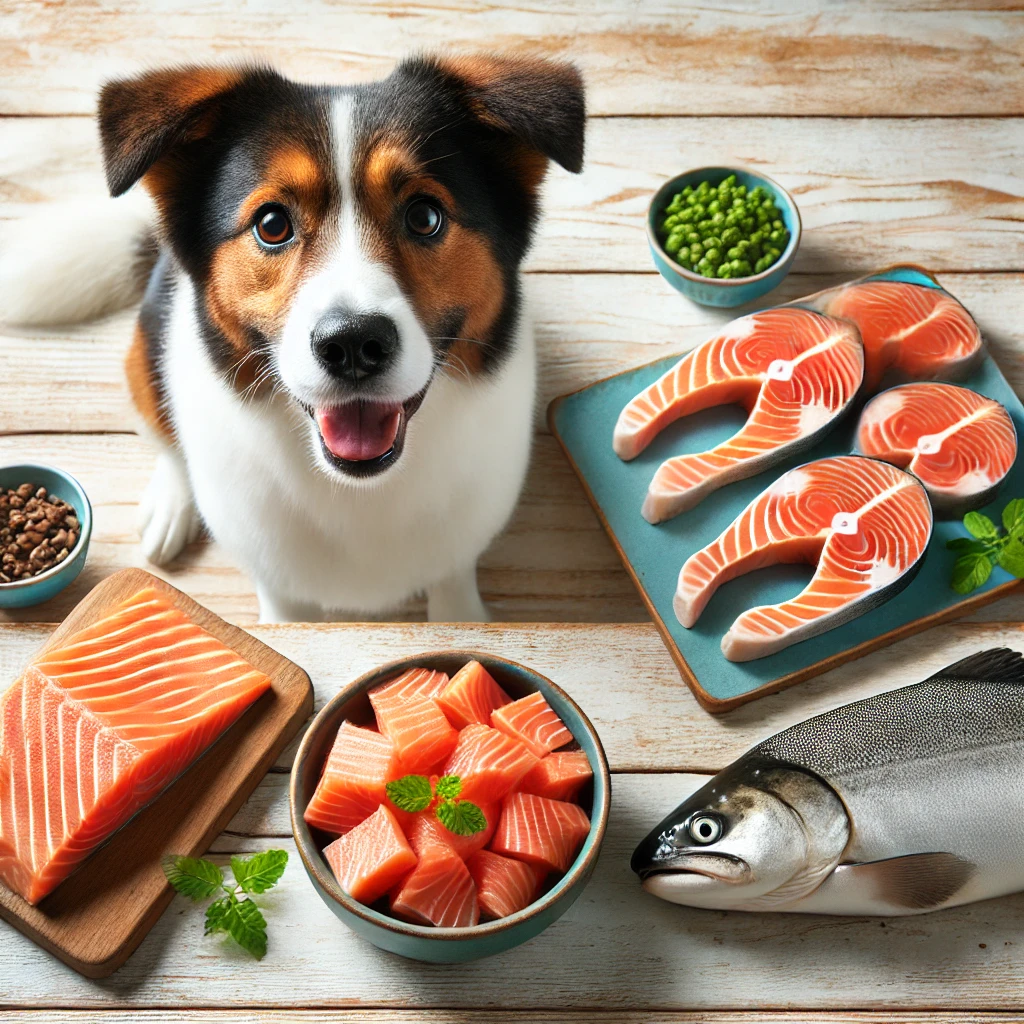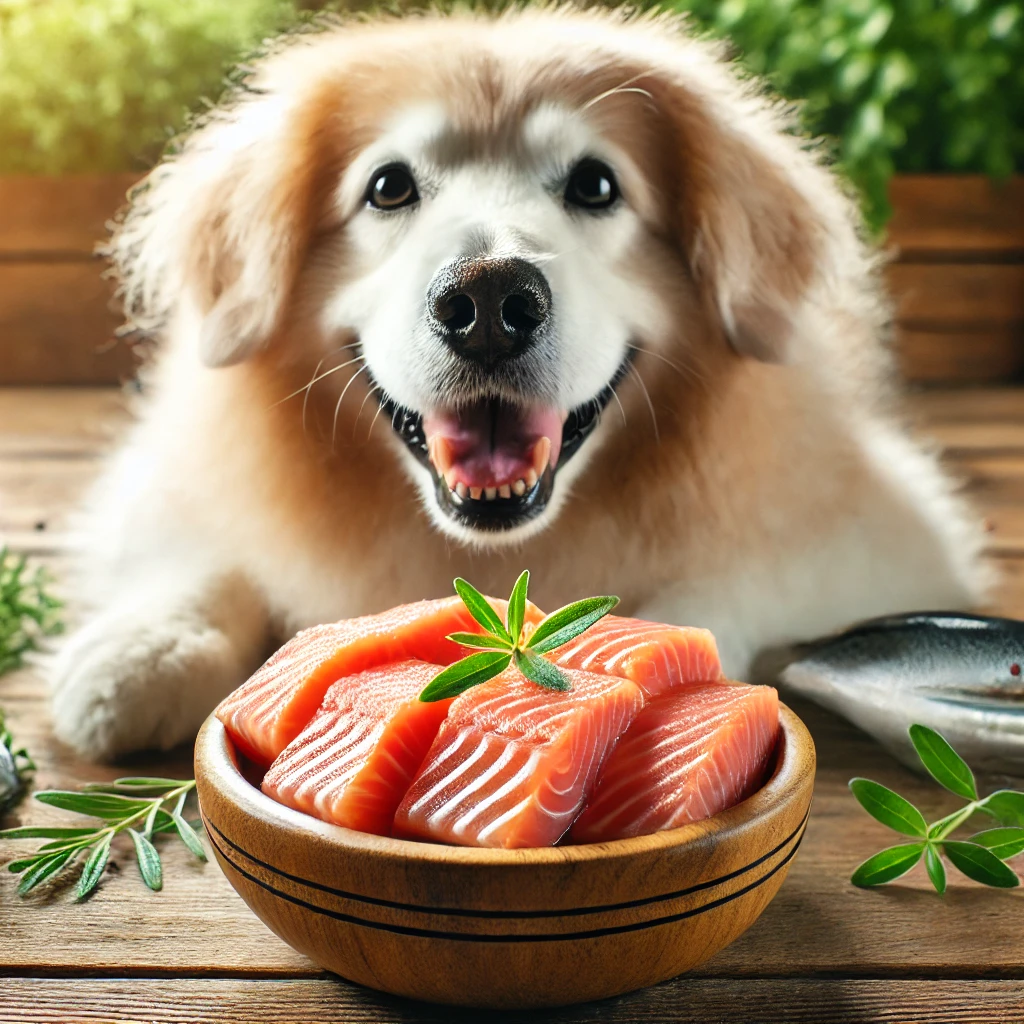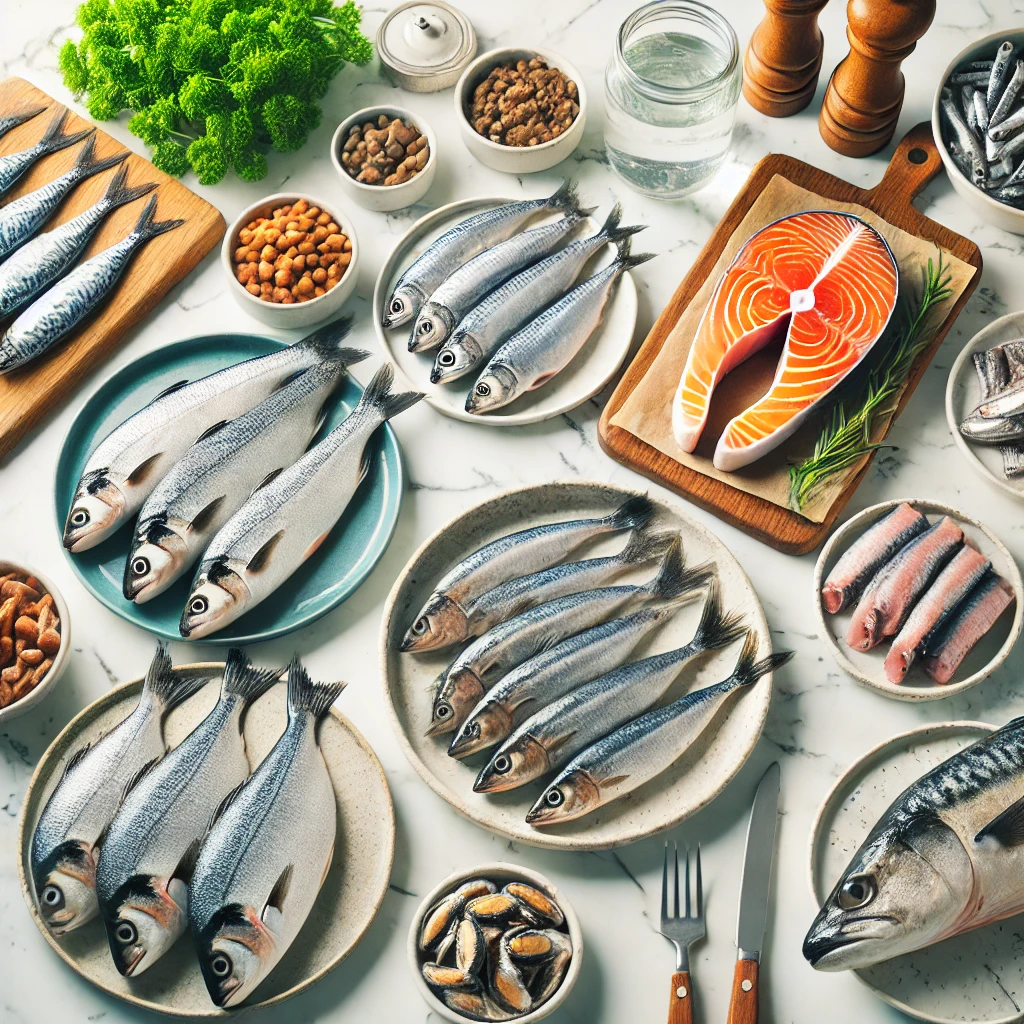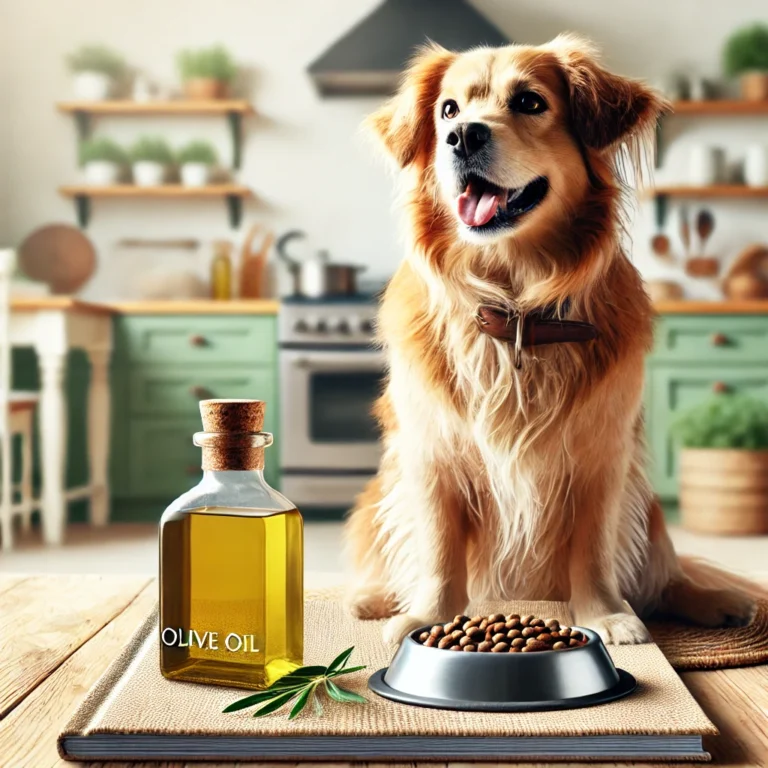
Wondering can dogs have salmon safely? Discover the dos and don’ts to keep your furry friend healthy with this tasty treat!
Salmon is a powerhouse of nutrition, well-loved for its delicious taste and numerous health benefits for humans.
But can our four-legged friends safely enjoy this fishy treat?
The answer is a cautious “yes”—if certain precautions are taken.
Feeding your dog salmon requires an understanding of both the benefits and potential risks to avoid common mistakes that could harm your dog.
This guide will cover everything from the best types of salmon, proper preparation methods, and recommended serving sizes to ensure your pup enjoys this fish safely.
Let’s dive in!
Nutritional Benefits of Salmon for Dogs
When it comes to pet nutrition, high-quality proteins and beneficial fats are essential, and salmon provides both.
Here’s a breakdown of why salmon can be a fantastic addition to your dog’s diet:
- Omega-3 Fatty Acids: Salmon is packed with Omega-3 fatty acids, specifically DHA and EPA, which play a crucial role in reducing inflammation. Omega-3s can help manage arthritis, improve heart health, and enhance skin and coat condition, making it beneficial for dogs with dry or itchy skin. Additionally, Omega-3s support cognitive function, making salmon especially beneficial for senior dogs.
- High-Quality Protein: Salmon is a lean source of protein, helping your dog maintain muscle health and energy levels. Protein is essential for tissue repair, immune support, and muscle development, especially in active or growing dogs.
- Vitamins and Minerals: Salmon is rich in B vitamins, potassium, selenium, and magnesium. These nutrients boost your dog’s energy levels, enhance immunity, and support thyroid function, providing a well-rounded nutritional boost.
Consider high-quality dog foods with salmon as a main ingredient, Purina Pro Plan SAVOR Adult Shredded Blend Salmon & Rice Formula, which combines balanced nutrition with the benefits of salmon.
The Dos of Feeding Salmon to Dogs

Ensuring your dog safely enjoys salmon means following a few crucial dos.
Here’s a guide to make sure you’re feeding salmon the right way.
- Do Choose Fresh, Wild-Caught Salmon: Not all salmon is created equal. Wild-caught salmon is preferable because it generally has fewer contaminants, antibiotics, and additives than farmed salmon. Farmed fish are often treated with chemicals, which can negatively affect dogs. Wild salmon is not only safer but also more nutrient-dense, providing higher-quality protein and Omega-3s.
Recommendation: Frozen Wild-Caught Alaskan Salmon for dog owners seeking a high-quality, easy-to-portion option.
2. Do Cook the Salmon Thoroughly: Raw or undercooked salmon can contain harmful parasites, such as Neorickettsia helminthoeca, which causes salmon poisoning disease. Cooking the salmon thoroughly destroys these parasites and harmful bacteria. Baked, grilled, or steamed salmon are ideal methods, but avoid frying, as the oil content can be too high for dogs.
3. Do Serve Salmon in Moderation: While salmon offers great health benefits, too much can lead to an excessive intake of fats and calories. It’s best to treat salmon as an occasional supplement to their regular diet, especially for dogs prone to weight gain. A weekly serving or two of small portions is sufficient.
- Do Remove Bones: Even though salmon bones are small and soft, they can still pose a choking hazard or get lodged in your dog’s throat. To be safe, always remove all bones from the fish before serving. Opt for boneless fillets whenever possible to reduce the risk.
Boneless options like Boneless Salmon Fillets can be a convenient and safe choice for pet owners.
The Don’ts of Feeding Salmon to Dogs
To avoid health risks, it’s essential to understand what not to do when feeding salmon to your dog. Here are the key don’ts for safe feeding:
- Don’t Serve Raw Salmon: Raw salmon can harbor parasites and bacteria that can lead to severe health issues. The parasite Neorickettsia helminthoeca causes salmon poisoning disease, which can be fatal if untreated. Symptoms include vomiting, diarrhea, fever, and lethargy. Avoid any risk by thoroughly cooking the salmon.
- Don’t Use Seasoned or Smoked Salmon: Many seasonings and ingredients used in smoked salmon are harmful to dogs. Ingredients like salt, garlic, and onion can cause serious health problems, from stomach upset to poisoning. Always serve plain, unseasoned salmon.
- Don’t Feed Salmon Skin: While salmon skin is not toxic, it is higher in fat and can contain contaminants. High-fat foods may lead to pancreatitis, an inflammatory condition that can cause abdominal pain, vomiting, and diarrhea. Avoid salmon skin unless you are sure it’s clean, cooked, and offered in very small amounts.
- Don’t Rely on Salmon for All Omega-3 Needs: Though salmon is an excellent source of Omega-3s, it shouldn’t be the only source. Supplements like Salmon Oil Omega-3 for Dogs can provide these nutrients consistently without needing to rely solely on salmon.
Preparing Salmon for Your Dog: A Step-by-Step Guide

Follow these steps to prepare salmon safely and correctly for your dog:
- Choose Boneless Fillets: Start by purchasing boneless salmon fillets. Even if you buy pre-boned fish, it’s a good idea to double-check for any small bones that could cause a choking hazard.
- Cook Plain and Thoroughly: Bake or steam the salmon at 375°F (190°C) for about 10–15 minutes, ensuring the fish is fully cooked. Avoid adding any seasonings, oils, or sauces, as these can irritate your dog’s stomach.
- Portion and Serve: Once cooked, cut the salmon into small, manageable pieces to serve alongside your dog’s regular food. This helps them digest it better and allows you to monitor portion sizes.
Recommendation: Dog Food Mat to help keep your dog’s feeding area clean, especially if serving fresh salmon alongside kibble.
How Much Salmon Can Dogs Eat? Portion and Frequency
Keeping salmon portions moderate is essential.
Too much can cause gastrointestinal upset or lead to weight gain over time.
Here’s a quick guide to safe serving sizes based on your dog’s weight:
- Small Dogs (under 20 lbs): 1–2 ounces of cooked salmon per serving.
- Medium Dogs (20–50 lbs): 2–4 ounces of cooked salmon per serving.
- Large Dogs (over 50 lbs): 4–6 ounces of cooked salmon per serving.
It’s best to limit salmon to once or twice a week to avoid potential digestive issues and excessive fat intake.
Recommendation: Digital Food Scale, which helps pet parents accurately measure salmon portions to avoid overfeeding.
Warning Signs: How to Know If Your Dog Reacted Poorly to Salmon
While salmon is generally safe when prepared correctly, dogs can still experience adverse reactions.
Watch for these symptoms, which could indicate salmon poisoning or other sensitivities:
- Vomiting and Diarrhea: These symptoms could suggest gastrointestinal upset or, in severe cases, salmon poisoning.
- Lethargy or Weakness: If your dog seems unusually tired or weak, this could be a sign of a reaction.
- Loss of Appetite: This could indicate a negative response to the salmon, especially if it persists over time.
If you observe any of these symptoms, contact your veterinarian immediately.
Acting quickly can make a huge difference in your dog’s recovery.
Types of Salmon: Choosing the Best Option for Your Dog
When it comes to feeding salmon to your dog, selecting the right type is essential to avoid potential contaminants, harmful additives, and unnecessary fat.
Here’s a breakdown of common types of salmon and what to consider:
- Wild-Caught Alaskan Salmon: This is the gold standard of salmon for dogs due to its lower levels of contaminants, antibiotics, and additives. Wild-caught Alaskan salmon has a cleaner nutrient profile compared to farm-raised salmon, offering high-quality Omega-3s and a balanced fat-to-protein ratio. It’s also more sustainable and less likely to be exposed to the chemicals often found in farmed fish.
- Sockeye Salmon: Known for its rich, red color, sockeye salmon is a variety of wild-caught salmon with a higher concentration of Omega-3 fatty acids and antioxidants. Sockeye is a nutrient-dense option that can support skin and coat health while providing a unique flavor your dog may enjoy.
- Atlantic Salmon (Farm-Raised): While commonly available, Atlantic salmon is usually farm-raised and may contain higher levels of contaminants like mercury, PCBs, and pesticides. Farm-raised fish are also often treated with antibiotics to prevent diseases in dense farming environments. While farmed salmon is safe in moderation, wild-caught varieties are preferred for their lower risk of contaminants.
- Canned Salmon: Canned salmon can be a convenient choice, especially for pet owners who don’t regularly buy fresh fish. Look for options packed in water without added salt or seasonings. Canned wild-caught Alaskan salmon can be a safe option, but always double-check the label to ensure it’s free from added ingredients. Canned salmon is softer and easy to portion, making it a good option for small or senior dogs.
Recommendation: Canned Wild Alaskan Salmon in Water for an easy and safe option for pet owners seeking quality and convenience.
Alternatives to Salmon: Other Dog-Friendly Fish Options

While salmon is a great option, adding variety with other safe, nutrient-dense fish can prevent boredom and offer balanced Omega-3 levels.
Here are some safe alternatives:
- Sardines: Sardines are rich in Omega-3 fatty acids and are lower in mercury than larger fish like tuna. They’re small, easy to serve whole, and offer an extra boost of calcium since the bones are safe for dogs to consume. Sardines can be a tasty treat for both large and small dogs and provide many of the same benefits as salmon.
- Whitefish: Whitefish (such as haddock or cod) is leaner and easier on the stomach, making it an excellent choice for dogs with sensitive digestion. Whitefish contains Omega-3s but in a lower concentration than salmon, so it’s best used in rotation with other fish options.
- Pollock: Pollock is another mild-flavored, lean fish that’s a popular ingredient in commercial dog foods. It’s an affordable source of protein and lower in mercury, making it suitable for dogs who need a lower-fat diet or are prone to weight gain.
- Mackerel: Mackerel is packed with Omega-3s and has a stronger flavor that dogs often love. However, it’s a fattier fish, so keep portion sizes small and offer it as an occasional treat to avoid excess fat intake.
- Trout: Trout is similar to salmon in nutrient content, providing Omega-3s, protein, and essential vitamins. However, it’s typically lower in contaminants than farm-raised salmon, making it a safer alternative.
Recommendation: Consider Canned Sardines in Water or Freeze-Dried Whitefish Dog Treats as easy-to-serve options for pet-safe, nutrient-rich fish.
Best Cooking Methods for Salmon: Tips for Optimal Dog Health
Cooking salmon properly is crucial to making it safe and nutritious for your dog.
Here are the top recommended cooking methods and tips for optimal health:
- Baking: Baking salmon at 375°F (190°C) for 10–15 minutes ensures the fish is cooked evenly without adding fats or oils. Baking preserves nutrients and makes it easy to portion. Use parchment paper to avoid sticking and skip any seasoning.
- Steaming: Steaming is a gentle cooking method that preserves nutrients and doesn’t require additional fats or oils. Steam salmon in a basket over boiling water for 8–10 minutes, or until it flakes easily with a fork. Steaming is an ideal choice for dogs prone to digestive sensitivities.
- Poaching: Poaching is another safe method. Place the salmon in a saucepan with just enough water to cover the fish, and simmer for 10–15 minutes until fully cooked. Avoid adding any seasonings, even salt, to the water.
- Grilling: Grilling can be safe if done without additional oils or seasonings. Place the salmon on a sheet of foil to avoid direct contact with the grill, and cook until it flakes easily. Keep an eye on the fish to avoid charring, which can produce harmful compounds for dogs.
- Avoid Frying: Frying is not recommended due to the high oil content, which adds unnecessary fat and can upset your dog’s stomach. Excess fat may also contribute to pancreatitis in dogs.
Recommendation: A Silicone Steaming Basket or Nonstick Baking Sheets to make cooking salmon for dogs safe and easy.
Safe Treats and Supplements: Adding Omega-3s to Your Dog’s Diet
If you’re looking to give your dog the benefits of salmon without cooking fish regularly, supplements and treats can be a convenient alternative.
Here are some safe and beneficial options:
- Salmon Oil Supplements: Salmon oil is a concentrated source of Omega-3 fatty acids that can be added to your dog’s regular meals. It’s beneficial for joint health, reducing inflammation, and improving skin and coat. A pump bottle is ideal for easy dosing—start with a small amount and gradually increase.
- Fish Oil Capsules: High-quality fish oil capsules made for dogs offer a controlled way to provide Omega-3s without needing to cook fish. Capsules are ideal for dogs with dry skin, arthritis, or allergies. Look for capsules made from wild-caught fish to ensure purity.
- Freeze-Dried Salmon Treats: Freeze-dried salmon treats are a convenient and mess-free way to offer your dog the flavor and nutrition of salmon without preparation. Freeze-drying retains most of the nutrients, and treats can be used as training rewards or occasional snacks.
- Omega-3 Chews: If your dog is picky about fish oil, Omega-3 chews flavored like bacon or peanut butter can be an appealing option. These chews provide the benefits of fish oil in a treat-like form, and some contain additional ingredients to support joint health.
- Flaxseed Oil as an Alternative: For pet parents who prefer plant-based options, flaxseed oil is rich in alpha-linolenic acid (ALA), a plant-based Omega-3. While not as potent as fish-based Omega-3s, it can still provide benefits when used as a supplement.
Recommendation: Wild Alaskan Salmon Oil for Dogs, Freeze-Dried Salmon Treats, and Omega-3 Chews for easy-to-use Omega-3 sources.
Common Questions and Misconceptions About Feeding Salmon to Dogs

Many pet owners have questions or uncertainties about feeding salmon to their dogs.
Here are some frequently asked questions to clear up common misconceptions:
- Can dogs eat smoked salmon? No, smoked salmon often contains high levels of salt and may be treated with spices or preservatives that can be harmful to dogs. The high sodium content can lead to dehydration or even salt poisoning, so it’s best avoided.
- Is raw salmon safe if it’s high-quality? Even high-quality raw salmon poses a risk of salmon poisoning disease, a potentially fatal condition caused by parasites found in raw fish. Cooking salmon thoroughly is the only way to make it safe for your dog.
- Does salmon have too much mercury for dogs? Salmon is a lower-mercury fish, so it’s generally safe when served in moderation. Unlike larger fish like tuna, salmon does not accumulate as much mercury. Sticking to wild-caught Alaskan salmon and serving it no more than once or twice a week can minimize mercury exposure.
- Can salmon cause allergies? Some dogs are allergic to fish, including salmon. If you’re feeding salmon for the first time, start with a small amount and monitor your dog for signs of an allergic reaction, such as itching, ear infections, or gastrointestinal upset.
- Is canned salmon safe? Canned salmon can be a safe alternative if packed in water and free from added salt, oils, or seasonings. Look for high-quality options that list only “salmon” and “water” as ingredients to ensure safety for your pet.
Recommendation: Natural Dog Allergy Support Supplement for pet owners with dogs prone to food sensitivities or allergies.
Conclusion: Can Dogs Have Salmon?
In summary, dogs can have salmon safely, and it can be a nutritious addition to their diet when prepared correctly.
Stick to wild-caught, boneless, and fully cooked salmon, served in moderation, to ensure your dog enjoys this treat without the risks.
Follow these dos and don’ts, and your pup will love this tasty, nutrient-rich food.
Always consult your vet before adding salmon or any new food to your dog’s diet. Ready to give your dog a taste of salmon?
Find safe, fresh, wild-caught fillets in the links above!
FAQ Section
- Can puppies have salmon? Yes, but it’s best to consult with your vet. Puppies have more sensitive digestive systems, so keep portions very small.
- Is canned salmon safe for dogs? Canned salmon can be an option if it’s packed in water and doesn’t contain any added salt or seasonings. However, fresh salmon is generally a better choice.
Related Articles:
Salmon Oil for Dogs: 7 Amazing Benefits Every Pet Parent Should Know
Can Dogs Eat Fish? Expert Answers and Best Fish Varieties for Dogs
Amazon Associate I earn from qualifying purchases.



